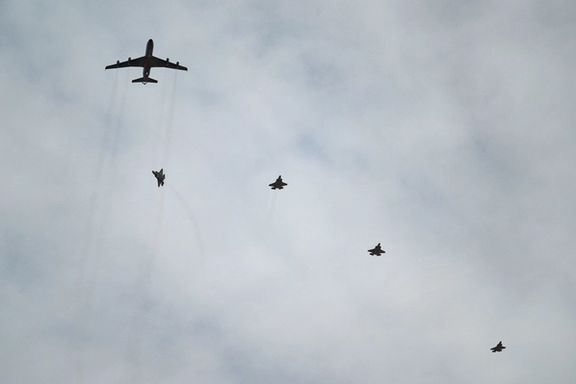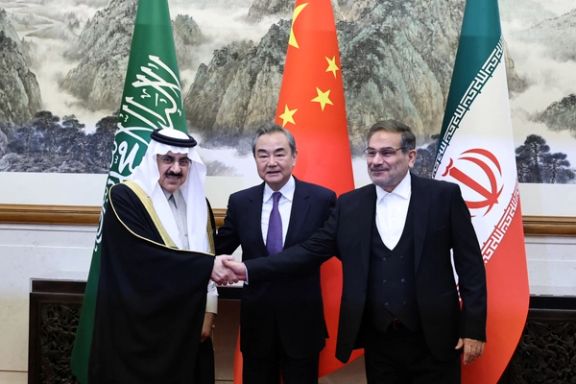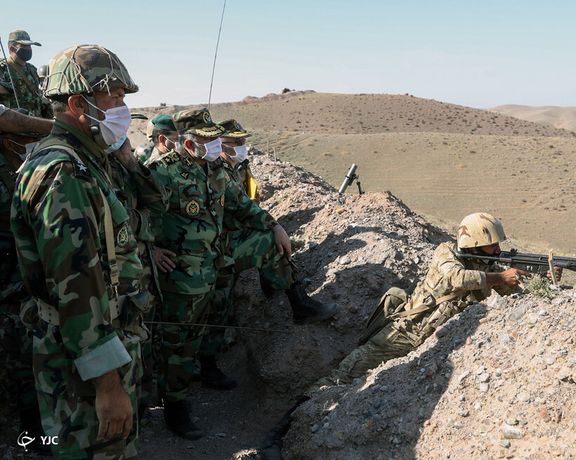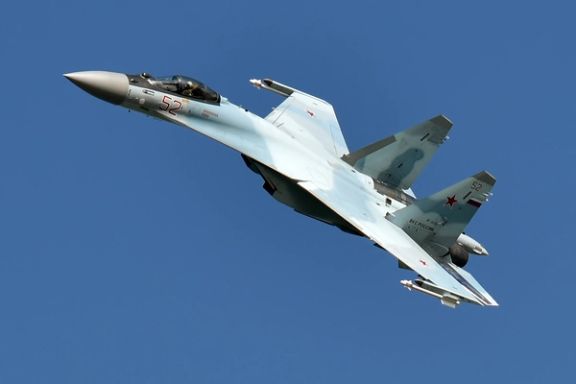Israel, US Launch Drills To Practice ‘Long-Range Aerial Scenarios’

The Israeli and US Air Force began a two-week joint training drill named Red Flag in Nellis Air Force Base, Nevada, on Sunday.

The Israeli and US Air Force began a two-week joint training drill named Red Flag in Nellis Air Force Base, Nevada, on Sunday.
According to the Israeli Defence Forces, the exercise aims to achieve “aerial superiority in the region” as it works on drills including "long-range aerial scenarios" in hints at a possible attack on Iran’s nuclear facilities.
The statement said the two week exercise will include a wide-range of capability training such as joint aerial strikes, area defense, interception of enemy aircraft, low-altitude flights and flights in areas abundant with anti-aircraft equipment.
The exercise will also include joint midair refuelings, where Israeli Air Force tanker aircraft will refuel American fighter jets, and an IAF F-35I “Adir” aircraft will be refueled by American KC-135 Stratotanker aircraft.
The exercise comes a few days after a meeting between US and Israeli officials in Washington, where the two countries pledged to prevent the Islamic Republic from acquiring nuclear weapons and further deter the hostile activities of Tehran in the region.
For the first time, seven IAF F-35I “Adir” aircraft and two IAF F-15I "Ra'am" aircraft will participate in the exercise in US territory. The exercise is taking place following the "Juniper Oak" exercise, the largest joint exercise to be conducted with USCENTCOM.
“The Red Flag exercise strengthens the operational cooperation between the two militaries as key partners committed to maintaining security in the Middle East,” the IDF spokesman’s unit said.

Agreement to restore relations with Iran does not mean disputes have been resolved, Saudi Foreign Minister Prince Faisal bin Farhan bin Abdullah has said.
In an interview with London-based Asharq Al-Awsat, bin Farhan emphasized that the agreement announced March 10 in Beijing with Chinese mediation and apparent guarantees, shows a joint desire by Iran and Saudi Arabia to “resolve disputes through communication and dialogue.”
He underscored, however, “This does not mean that an agreement has been reached to resolve all pending disputes between them.”
The biggest dispute is the conflict in Yemen where the two countries have fought each other indirectly for 8 years. Iran has backed Houthi rebels who pushed the internationally recognized government out of the capital and proceeded to conquer territories beyond their ethnic-religious traditional domain.
As Saudi Arabia backed the anti-Houthi forces with direct military involvement, Houthis used Iranian missiles and drones to launch hundreds of attacks against targets inside Saudi territory.
Most analysts believe that Riyadh wants to end the Yemen conflict as it embarks on an ever-ambitious plan of economic development, which needs security.

Executive Director of The Washington Institute Robert Sadloff in a long series of tweets Sunday referred to the Saudi quest for fast economic growth, quoting a senior Saudi official who said growth “can be sidetracked through insecurity, whether from Houthi missiles or the threat of [Iranian] nuclear blackmail.”
The Saudi foreign minister in his interview emphasized the economic factor. “We, in the Kingdom, hope to open a new chapter with Iran and bolster cooperation that would consolidate security and stability and push forward development and prosperity, not just in both our countries, but the entire region.”
Former Iranian diplomat Javid Qorban-Ogli told Didban website in Tehran Monday that ending the Yemen conflict is the top Saudi objective. “Saudi Arabia is a conservative regime which tries to avoid headaches. It pursues an ambitious development plan, which needs security and stability in the region.”
He also listed Tehran’s reasons for resuming relations with Riyadh. “Iran, the other side in this agreement, is facing a serious economic crisis, social and political chaos and multiple other crises because of its wrong foreign policy.” The third actor in this deal is China, he said, adding that Beijing seeks “energy security.”
Iran’s foreign ministry spokesman Naser Kanaani Monday reiterated that the agreement with the Saudis is the result of nearly two years of talks in Baghdad and Oman, taken to a higher level in recent months by Chinese mediation. His remark shows that although the two sides could have reached an agreement without Beijing, one or both countries at some point decided to have China some sort of guarantor.
Sadloff also argued in his tweets that Riyadh to an extent lost confidence in the Biden administration for securing Iran’s containment. As Tehran expands it nuclear program getting closer to a nuclear threshold state and Washington maintains restrictions on arms sales to Riyadh, Saudi Arabia’s confidence in receiving American protection decreased.
“Resuming ties with Iran is a dramatic expression of this lack of confidence in US,” Sadloff said.

A committee chairman in the US House of Representatives says the Chinese-mediated agreement between Iran and Saudi Arabia to restore diplomatic ties is “very troubling.”
Michael R. Turner, Republican from Ohio has said in an interview with ABC News that it is disappointing to see Saudi Arabia look elsewhere except the US for support.
“I think that, of course, is a reflection on the Biden administration,” Turner said on Sunday, adding that “It’s not unexpected that [Saudi Arabia] might look elsewhere for support. It certainly is very unexpected and certainly very troubling and disappointing that they would turn to Iran.”
The Islamic Republic and Saudi Arabia agreed to re-establish diplomatic ties after Chinese-brokered talks in Beijing. Following five days of negotiations, it was agreed on Friday that the two countries will reinstate embassies and missions after seven years of no diplomatic relations and occasional tensions.
Saudi Arabia severed relations with the Islamic Republic in January 2016 after hardliner supporters of Supreme Leader Ali Khamenei formed mobs and attacked and ransacked its embassy in Tehran and consulate in Mashhad following the execution of a Saudi Shiite cleric.
Turner, who heads the House Intelligence Committee, further criticized the Biden Administration saying US officials have been slow to respond to Riyadh’s military needs.
“The Biden administration appears to be much too timid… in their approach to Russia… and I think even in China they are afraid to provoke,” Turner added. “They are absolutely emerging as a military threat to the United States. I think we need to respond and respond very strongly.”

Saudi Arabia will watch Iran's behavior during the two-month window agreed upon to restore relations, Saudi columnists said on Sunday.
The opinion reflected continued wariness in the longtime rivalry between the region's Sunni Muslim and Shi'ite powers.
The breakthrough on Friday brokered by China, a major trade partner of both countries, followed several rounds of Saudi-Iranian talks held in the region in a bid to contain tensions, at a time of frustration by Saudi Arabia and regional allies over what they perceive as gradual US disengagement from the region and negotiations with Iran.
Tehran and Riyadh said they had agreed to resume diplomatic relations and re-open embassies within two months, adding that their foreign minister would meet to implement the deal, without mentioning a more detailed timeline.
"The two-month period ... is the first test of Iran's credibility and proof of good intentions as we must see the start of real change in the regional landscape and a real correction in its dealings with the Kingdom," Saudi columnist Hamoud Abu Taleb wrote in Okaz, a Saudi daily.
A main source of tension is Yemen, where Riyadh leads a military coalition that has since 2015 been battling the Iran-aligned Houthi movement -- which has during the war launched missile and drones at the kingdom.
Abdullah al-Otaibi, in an Op-ed in Saudi-owned Asharq Al-Awsat newspaper, agreed the timeline to reopen embassies would "test" Iran's commitment and said Beijing could play a more effective role than "failed" Western efforts with Tehran.
Persian Gulf Arab states have grown increasingly disillusioned with key ally and security guarantor the United States, including over global powers' 2015 nuclear pact with Iran which they deemed flawed for not tackling Iran's missile program and proxies.
Since the news of the Iranian-Saudi deal broke on Friday, many commentators have seen the development as a win for China that brokered the agreement.
The Wall Street Journal in an editorial blamed Biden and the Democrats for annoying the Saudis and pushing them into China’s arms. The Journal said, “the symbolic import is hard to miss as Democrats in Washington do everything they can to harass and annoy the Saudis,” adding that getting a cold shoulder from Washington Riyadh decided to “hedge” its bets.
Saudi Arabia and the United Arab Emirates have moved to assert more control over regional stability by pursuing conciliatory foreign policies they hope will allow them to focus on economic priorities.
The Wall Street Journal and the New York Times reported this week that Saudi Arabia is demanding concessions from the Biden administration to join the peace accords with Israel. It wants US assistance in developing a nuclear power industry and less restrictions on arms sales to the kingdom. Many see the Chinese-brokered deal with Iran as further pressure by Riyadh on both the United States and Israel.
"It is natural to have diplomatic ties even if at a low level because Iran's expansionist approach has created many touch points with Saudi Arabia....(But) we have to keep our eyes open," wrote Saudi columnist Tariq al-Homayed.
"China is the guarantor for this agreement. This will be important if Iran does not comply," he added.
The United States has voiced reservations about deepening ties between Persian Gulf states and its economic rival China, whose president attended a Gulf summit in Riyadh last year at a time of severe strains in the strategic US-Saudi relationship.
Riyadh and Abu Dhabi have repeatedly said they are looking to diversify their strategic partners while pressing Washington for concrete commitments to regional security.
With reporting by Reuters

Foreign Ministry of Azerbaijan summoned the Iranian ambassador in Baku Saturday to protest the flight of an Iranian warplane on the border of the two countries.
Ambassador Abbas Mousavi was called to the foreign ministry and told that Saturday morning local time a warplane continuously flew near the Azerbaijani border for more than 40 minutes at a distance of 3-5 kilometers.
Azerbaijan called the incident “provocative and unfriendly.”
A statement issued by Baku said that the Islamic Republic also held “large-scale military drills last year along the Aras river near the borders of Azerbaijan.”
An attack by a gunman on Azerbaijani embassy in Tehran in January that killed the missions security chief led to heightened tension between the two countries.
Relations have been tense since 2020 when Azerbaijan defeated Armenia in a war and recaptured territory occupied by Armenian forces since the early 1990s. It then took further military action in 2022 trying to occupy territory in Armenia proper, threatening to cut off Iran’s link with its northern neighbor. Iran has repeatedly warned Baku not to attempt to change international borders.
Tehran also accuses Baku of harboring Israeli intelligence and military elements that plan to use its territory in a possible attack against Iran’s nuclear installations.
However, Azerbaijan's ambassador-designate to Israel Mukhtar Mammadov said recently that his country would not allow Israel’s military to use its territory as a base for a possible attack against Iran.
Mammadov also rejected reports that Azerbaijan would allow the Mossad to set up a branch in Azerbaijan to monitor what is happening in Iran.

Iran has reached a deal to buy advanced Su-35 fighter planes from Russia, Iranian state media says, expanding its controversial military ties with Moscow.
"The Sukhoi-35 fighter planes are technically acceptable to Iran and Iran has finalized a contract for their purchase," the broadcaster IRIB quoted Iran's mission to the United Nations as saying in New York.
The report did not carry any Russian confirmation of the deal, details of which were not disclosed. The mission said Iran had also inquired about buying military aircraft from several other, unnamed countries, IRIB reported.
Russian President Vladimir Putin met Iranian Supreme Leader Ayatollah Ali Khamenei in Tehran last July, stressing closer ties in the face of Western pressure over the war in Ukraine.
Iran has has supplied hundreds of kamikaze drones to Russia that have been used to target Ukraine's military and civilian infrastructure. Moscow denies that its forces use Iranian-built drones in Ukraine, although many have been shot down and recovered there.
Iran’s air force has only a few dozen strike aircraft: Russian jets as well as ageing US models acquired before the Iranian revolution of 1979. Instead, Iran has developed a variety of drones and missiles see n as a threat for other regional countries.
In 2018, Iran said it had started production of the locally designed Kowsar fighter for use in its air force. Some military experts believe the jet is a carbon copy of an F-5 first produced in the United States in the 1960s.
With reporting by Reuters